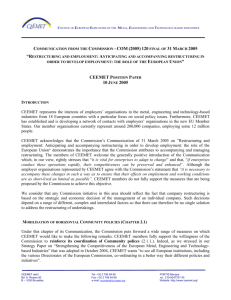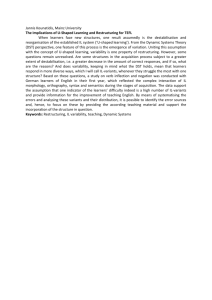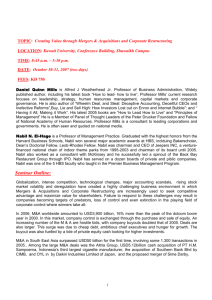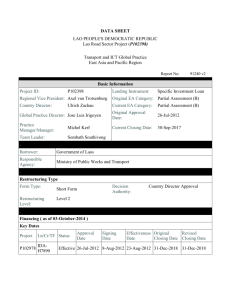Corporate Restructuring
advertisement
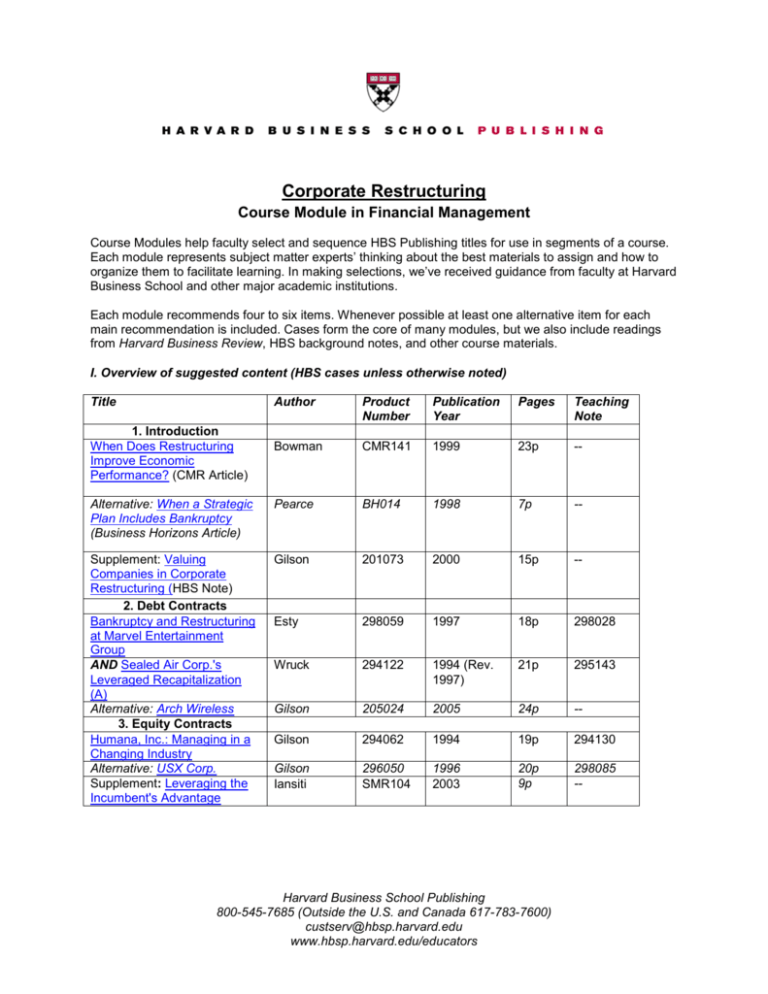
Corporate Restructuring Course Module in Financial Management Course Modules help faculty select and sequence HBS Publishing titles for use in segments of a course. Each module represents subject matter experts’ thinking about the best materials to assign and how to organize them to facilitate learning. In making selections, we’ve received guidance from faculty at Harvard Business School and other major academic institutions. Each module recommends four to six items. Whenever possible at least one alternative item for each main recommendation is included. Cases form the core of many modules, but we also include readings from Harvard Business Review, HBS background notes, and other course materials. I. Overview of suggested content (HBS cases unless otherwise noted) Title Author Product Number Publication Year Pages Teaching Note Bowman CMR141 1999 23p -- Alternative: When a Strategic Plan Includes Bankruptcy (Business Horizons Article) Pearce BH014 1998 7p -- Supplement: Valuing Companies in Corporate Restructuring (HBS Note) 2. Debt Contracts Bankruptcy and Restructuring at Marvel Entertainment Group AND Sealed Air Corp.'s Leveraged Recapitalization (A) Alternative: Arch Wireless 3. Equity Contracts Humana, Inc.: Managing in a Changing Industry Alternative: USX Corp. Supplement: Leveraging the Incumbent's Advantage Gilson 201073 2000 15p -- Esty 298059 1997 18p 298028 Wruck 294122 1994 (Rev. 1997) 21p 295143 Gilson 205024 2005 24p -- Gilson 294062 1994 19p 294130 Gilson Iansiti 296050 SMR104 1996 2003 20p 9p 298085 -- 1. Introduction When Does Restructuring Improve Economic Performance? (CMR Article) Harvard Business School Publishing 800-545-7685 (Outside the U.S. and Canada 617-783-7600) custserv@hbsp.harvard.edu www.hbsp.harvard.edu/educators Corporate Restructuring: An HBSP Course Module 4. Employee Contracts Scott Paper Co. Alternative: Offshoring at Global Information Systems, Inc. 5. Tax Claims Seagate Technology Buyout Gilson 296048 28p 298088 204144 1996 (Rev. 1997) 2004 Fruhan 19p 204145 Andrade 201063 2001 19p 204160 II. Rationale for selection and sequencing the items in this module Deciding when a corporate restructuring is appropriate and managing the process well have become increasingly important skills for executives in the last several decades. The leading California Management Review Article “When Does Restructuring Improve Economic Performance?” provides an excellent conceptual and statistical overview of this trend. Summarizing research on 5,000 company restructurings, the authors distinguish and describe situations when three types of restructuring─portfolio, financial, and organizational─are successfu l. The alternative Business Horizons Article describes situations when pursing a type of financial restructuring—a reorganization bankruptcy—is a viable business strategy. This promises creditors maximum repayment in the future if a strategic turnaround is successful. The supplementary technical note “Valuing Companies in Corporate Restructuring” assesses the effectiveness of discounted cash flow (DCF) and market value multiples valuation methods in the context of leveraged restructurings and turnaround timing. Being able to estimate the likely impact of a restructuring on a company’s enterprise value is essential for managers and claimholders. The cases in the module are sequenced by the four main types of claims on a company: debt (segment 2), equity (segment 3), employee (segment 4), and taxes (segment 5). The debt segment pairs two bestsellers, Bankruptcy and Restructuring at Marvel Entertainment Group and Sealed Air Corp.'s Leveraged Recapitalization (A). The Marvel case shows management reacting to a distress situation and debtholder-equityholder conflict. In contrast, Sealed Air illustrates the proactive use of a financial restructuring to stimulate deep organizational change. The alternative, Arch Wireless, looks at debt subordination and valuation issues in a telecommunications bankruptcy. Segment 3 requires students to assess corporate spin-offs as a portfolio restructuring option. The timetested primary case, Humana, Inc.: Managing in a Changing Industry, evaluates the qualitative and quantitative benefits a spin-off would bring to an integrated healthcare provider whose strategy of running both hospitals and health maintenance organizations (HMO) has led to declining profits. The alternative case, USX Corp. focuses on two methods to address undervaluation of corporate stock: a diversified steel firm proposes to develop tracking stock, while a corporate raider pressures it to spin-off part of the business. The supplementary Sloan Management Review article “Leveraging the Incumbent's Advantage” discusses the strategic pros and cons of spin-offs in the Internet age. Harvard Business School Publishing 800-545-7685 (Outside the U.S. and Canada 617-783-7600) custserv@hbsp.harvard.edu www.hbsp.harvard.edu/educators Corporate Restructuring: An HBSP Course Module Segment 4 turns to the issue of restructuring employee contracts under financial pressure. The leading case, Scott Paper Company, examines the massive layoffs and downsizing that the company experienced under “Chainsaw” Al Dunlap. The case highlights alternatives to layoffs, sources of shareholder value creation, and issues in executive compensation. The alternative case, Offshoring at Global Information Systems, Inc. offers several perspectives on moving computer programming jobs offshore to look at the employee cost issues that globalization poses. In Segment 5, the module concludes with a case on tax claims. The multi-faceted Seagate Technology Buyout case concerns a leveraged buyout deal that will bring tremendous tax savings. Note: The organizing structure of this module is drawn to a large extent from the Harvard Business School MBA course “Creating Value Through Corporate Restructuring,” developed by Professor Stuart Gilson. III. Detailed description of recommended items 1. Introduction When Does Restructuring Improve Economic Performance? Edward H. Bowman; Harpreet Singh; Michael Useem; Raja Bhadury (California Management Review Article) Corporate restructuring has been the focus of much debate in the past few years. This article addresses the debate about the effectiveness of corporate restructuring by examining 52 studies presented within 25 research articles on restructuring and its impact on economic performance. The authors distinguish three forms of restructuring: financial, portfolio, and organizational. Based on the research reviewed here, financial restructuring has the highest positive impact on performance, followed by portfolio restructuring. Organizational restructuring has little consistent impact on performance. Subjects: Economic analysis; Financial strategy; Reorganization; Restructuring Length: 23p • • Describes three broad types of restructuring: portfolio (changes in assets and lines of business); financial (changes in capital structure), and organizational (changes in organizational structure). For each restructuring type, the article provides reasons why companies undertake such transformations; summarizes the research evidence on that method’s effectiveness; describes one research study in detail; gives a mini-case study of a successful company restructuring; and concludes with implementation recommendations for managers. Alternative: When a Strategic Plan Includes Bankruptcy John A. Pearce II; Samuel A. DiLullo (Business Horizons Article) In an average week, more than 300 companies fail. And more than 75% of those desperate firms file for a "liquidation bankruptcy," agreeing to a complete distribution of their assets to creditors. The remaining 25% refuse to surrender until a final option is exhausted: petitioning the courts for a "reorganization bankruptcy," trying to persuade its creditors to freeze their claims temporarily while it reorganizes to rebuild profitable operations. Proper and timely use of reorganization bankruptcy can bring relief from otherwise devastating indebtedness; chosen for the right reasons and correctly implemented, it can provide a financially, strategically, and ethically sound basis for serving the interests of all stakeholders. A Harvard Business School Publishing 800-545-7685 (Outside the U.S. and Canada 617-783-7600) custserv@hbsp.harvard.edu www.hbsp.harvard.edu/educators Corporate Restructuring: An HBSP Course Module model is offered for analysis of the bankruptcy situation and the turnaround response. The successful integration of reorganization bankruptcy as a key component of a strategic plan is based on an understanding of bankruptcy law and how its provisions affect the company, as well as the timely use of Chapter 11 protection as it was intended--to retrench systematically and put together a new strategy that evokes support of all stakeholders. It should never become a popular strategic choice; but if properly exercised, it can revive a deserving organization. Subjects: Bankruptcy; Bankruptcy reorganization; Business failures; Corporate strategy; Entrepreneurial finance; Entrepreneurship; Government policy Length: 7p Supplement: Valuing Companies in Corporate Restructuring Stuart C. Gilson (HBS Technical Note) This case provides a technical overview of different valuation techniques for use in valuing companies in corporate restructuring. Techniques covered include adjusted present value, WACC, capital cash flow, and discounted cash flow valuation. Specific numerical examples are provided. Learning Objective: To provide students with a practical reference guide on corporate valuation techniques. Subjects: Discounts; Present value; Restructuring; Valuation Length:15p 2. Debt Contracts Bankruptcy and Restructuring at Marvel Entertainment Group Benjamin C. Esty; Jason S. Auerbach Marvel Entertainment Group is the leading comic book publisher in the United States, with superheros like Spider-Man, the Incredible Hulk, the X-Men, and Captain America. It is also one of the leading manufacturers of sports and entertainment trading cards under the Fleer and Sky Box brand names. In the mid-1990s, it experienced sharp declines in both businesses, causing it to file for bankruptcy in December 1996. This case is set in late January 1997, shortly after Marvel filed its reorganization plan with the bankruptcy court and approximately one month before creditors will have to vote on the plan at the confirmation hearing. Two of the most prominent corporate raiders of the 1980s are pitted against each other for control of the company. On one side is Ronald Perelman, who controls Marvel through his MacAndrews & Forbes holding company. On the other side is Carl Icahn, who controls 25% of Marvel's public debt. Icahn and the other bondholders must decide whether to accept Perelman's plan, to reject it in favor of their own plan, or to sell their bonds before the confirmation hearing. Perelman must decide whether to change the plan in response to the debtholders' threats or to wait and see what happens at the hearing. A rewritten version of another case. Learning Objective: This case has four objectives: 1) To provide an opportunity to value a Chapter 11 restructuring plan; 2) to illustrate debtholder/equityholder incentive conflicts in a distress setting; 3) to raise the issue of whether insider-trade in debt instruments, specifically junior debt in a distress situation, should be illegal; and 4) to illustrate the role played by vulture investors in Chapter 11 restructurings. Subjects: Bankruptcy; Corporate governance; Liquidation; Restructuring; Valuation Setting: United States; Media; $800 million revenues; 1,600 employees; 1997 Length:18p • Assumes students are familiar with U.S. bankruptcy laws and capital cash flow method; if not, recommends: Note on Bankruptcy in United States (292069) and Note on Capital Cash Flow Valuation (295069) as supplements. Sealed Air Corp.'s Leveraged Recapitalization (A) Karen H. Wruck; Brian Barry Harvard Business School Publishing 800-545-7685 (Outside the U.S. and Canada 617-783-7600) custserv@hbsp.harvard.edu www.hbsp.harvard.edu/educators Corporate Restructuring: An HBSP Course Module Less than a year after Sealed Air embarked on a program to improve manufacturing efficiency and product quality, the company borrowed almost 90% of the market value of its common stock and paid it out as a special dividend to shareholders. Management purposefully and successfully used the leveraged recapitalization as a watershed event, creating a crisis that disrupted the status quo and promoted internal change, which included establishing a new objective, changing compensation systems, and reorganizing manufacturing and capital budgeting processes. Product Description: Less than a year after Sealed Air embarked on a program to improve manufacturing efficiency and product quality, the company borrowed almost 90% of the market value of its common stock and paid it out as a special dividend to shareholders. Management purposefully and successfully used the leveraged recapitalization as a watershed event, creating a crisis that disrupted the status quo and promoted internal change, which included establishing a new objective, changing compensation systems, and reorganizing manufacturing and capital budgeting processes. Learning Objective: To provide a context in which students can explore how financing decisions affect organizational structure, management decision making, and firm value. Can be used as an introductory finance case in which the students apply basic cash flow forecasting techniques to explore alternative dividend and capital structure decisions. For more advanced finance classes, the concept of free cashflow, its effect on stock market prices and firm value, and the disciplinary role of high leverage can be analyzed. Subjects: Capital structure; Change management; Control systems; Crisis management; Debt management; Dividends; ESOP; Recapitalization Supplements: Supplement (Library), (294123), 8p, by Karen H. Wruck ; Brian Barry Setting: New Jersey; Packaging, carton & container industries; mid-size; $385 million sales; 2,000 employees; 1989; Length: 21p • • One or two-day teaching plan. If a two-day plan is followed, the first day focuses on dividend policy and Sealed Air’s debt capacity; day two on organizational change and the (B) case. Supplement: Sealed Air Corp.'s Leveraged Recapitalization (B), 294123 Alternative: Arch Wireless, Inc. Stuart C. Gilson ; Perry L. Fagan The largest wireless paging company in the United States has to restructure its debt in response to the collapse of its market. The restructuring faces formidable challenges. Valuing the company is extremely difficult because Arch's public competitors are also severely troubled and the industry's future is highly uncertain. In addition, the company has an extremely complicated parent-subsidiary holding company structure. Learning Objective: To look at structural subordination, contractual subordination, secured debt, and substantive consolidation in bankruptcy as well as debt security and subordination, restructuring, and Chapter 11. Subjects: Bankruptcy; Capital structure; Debt management; Reorganization; Restructuring; Strategy formulation; Telecommunications; Valuation Setting: Massachusetts; Wireless carriers; $1 billion revenues; 2001-2002 Length: 24p 3. Equity Contracts Humana, Inc.: Managing in a Changing Industry Stuart C. Gilson Intensifying competition and change in the U.S. health care industry force a large integrated health-care provider to reassess its strategy of operating both hospitals and health insurance plans (HMOs). In an Harvard Business School Publishing 800-545-7685 (Outside the U.S. and Canada 617-783-7600) custserv@hbsp.harvard.edu www.hbsp.harvard.edu/educators Corporate Restructuring: An HBSP Course Module attempt to increase its stock price and operating performance, the company considers a number of alternative restructuring strategies for separating the two businesses, including a corporate spinoff. Learning Objective: To illustrate how a company under financial stress can use a corporate spinoff to increase its stock market value and effect real improvements in its business. Also, to highlight the importance of choosing a financial restructuring strategy that fits the firm's underlying business or strategic problems. Subjects: Corporate strategy; Cost allocation; Financial strategy; Reorganization; Restructuring Setting: Louisville, KY; Health care industry; large; $6 billion revenues; 5,000 employees; 1992 Length: 19p Alternative: USX Corp. Stuart C. Gilson; Jeremy Cott A large diversified steel and energy firm is pressured by a corporate raider to spin off its steel business in order to increase its stock price. As an alternative to the spinoff, management proposes replacing the company's common stock with two new classes of "targeted" stock that would represent separate claims against each business segment's cash flows, allowing the stock market to value each business separately (and more accurately). Learning Objective: To provide an opportunity for students to compare alternative restructuring strategies that have the same objective (in this case, to increase the company's stock price by segmenting cash flows from its distinct businesses). Subjects: Corporate governance; Cost allocation; Diversification; Incentives; Restructuring; Valuation Setting: Pittsburg, PA; Steel industry; $20 billion revenues; 42,500 employees; 1990 - 1991 Length: 20p • • Bestseller If both the Humana and USX cases are used, then the Humana case should precede USX, so students become familiar with the basic mechanics of spinoffs before evaluating their relative advantages in USX. Supplement: Leveraging the Incumbent's Advantage Marco Iansiti; F. Warren McFarlan; George Westerman (Sloan Management Review Article) People often talk about business competition as if it's a short race: Get to market first and you are bound to win. Indeed, the importance of first-mover advantage has been drummed into the heads of many business executives, and some have almost been brainwashed to think that speed is everything. But when a new technology like the Internet threatens to transform an industry, the companies that are quickest to respond aren't necessarily the ones that reap the greatest benefits. In fact, choosing a fast strategy can lock them into a set of decisions that actually hurt them in the long run. Instead, organizations that choose the right strategy for the entire race--both for the early and late stages--will come out ahead. The authors have found that companies that respond quickly by launching a spin-off usually have difficulty achieving true staying power in the market. For enduring success, incumbent companies are better off creating a group that is--or will eventually be--integrated within their organizations. Only then will they be able to tap fully into their numerous strengths and assets, leveraging their incumbent's advantage. Subjects:Corporate strategy; Innovation; Strategy formulation; Length: 9p 4. Employee Contracts Scott Paper Co. Stuart C. Gilson; Jeremy Cott Harvard Business School Publishing 800-545-7685 (Outside the U.S. and Canada 617-783-7600) custserv@hbsp.harvard.edu www.hbsp.harvard.edu/educators Corporate Restructuring: An HBSP Course Module A professional turnaround manager attempts to implement a massive global downsizing program at the world's largest producer of consumer tissue products. The plan involves laying off almost one third of the company's 34,000 hourly and salaried employees and dramatically changing the company's business focus through massive asset sales-all in less than a year. Learning Objective: To provide students with a fascinating "inside look" at a corporate downsizing program and give them the opportunity to discuss how such a program should be designed and implemented to create maximum value for stockholders and other corporate stakeholders. The case also allows students to analyze the sources of value in corporate downsizing (i.e., whether stock price gains that result from downsizing reflect value creation or value transfers). Subjects: Executive committees; Labor negotiations; Reengineering; Restructuring; Shutdowns Setting: Philadelphia, PA; Paper industry; $4.7 billion revenues; 31,000 employees; 1994; Length: 28p Alternative: Offshoring at Global Information Systems, Inc. William E. Fruhan Jr. This case explores the topic of offshoring high-tech jobs several perspectives. The issues presented include determining the stock price consequences of offshoring, examining the economic consequences of the offshore job to both the transferring and receiving countries, considering the competitive consequences of not offshoring, and thinking through the challenge of investing in a career that is vulnerable to future offshoring. Learning Objective: To explore all the issues involved in offshoring jobs. Subjects: Career changes; High technology; Information technology; International operations; Operations management; Outsourcing Setting: United States; IT industry; $87 billion revenues; 300,000; 2004 Length: 19p 5. Tax Claims Seagate Technology Buyout Gregor Andrade; Todd Pulvino; Stuart C. Gilson In March 2000, a group of private investors and senior managers were negotiating a deal to acquire the disk drive operations of Seagate Technology. The motivating factor for the buyout was the apparently anomalous market value of Seagate's equity: Seagate's equity value was just a fraction of the value of its minority stake in Veritas Software Corp., a software maker. The investor group had to decide how much to offer for the operating assets, as well as how to finance the transaction. Further complicating the analysis was the fact that, unlike in traditional buyout settings, the target company was in a highly cyclical, volatile, and capital--intensive industry. Learning Objective: To illustrate cash flow valuation (adjusted present value and WACC), including estimating the cost of capital from comparables, as well as the impact of financing decisions on value; to discuss leveraged buyouts, both in traditional settings within mature industries, as well as in the more volatile technology sector; to discuss tax implications associated with corporate divestitures; and to qualitatively evaluate potential costs of financial distress in a capital-intensive technology-driven setting. Subjects: Capital structure; Financial strategy; Leveraged buyouts; Mergers & Acquisitions; Present value; Software; Valuation Setting: Silicon Valley; Computer hardware; $6.8 billion revenues; 2000 Length: 19p Harvard Business School Publishing 800-545-7685 (Outside the U.S. and Canada 617-783-7600) custserv@hbsp.harvard.edu www.hbsp.harvard.edu/educators



